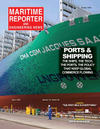
Page 46: of Maritime Reporter Magazine (October 2020)
Shipping & Port Annual
Read this page in Pdf, Flash or Html5 edition of October 2020 Maritime Reporter Magazine
Tech Talk | 2020 SHIPPING & PORT ANNUAL
Fighting
Container
Fires
Photos: Survitec ire safety has become a major towed to a port of refuge. from the outset and should form the concern in the container ship- This is just one example from a grow- basis of the design process of any new ping industry, in particular, with ing list of large container ship ? res in container vessel. But it is not just ship
Fvessels of 20,000-TEU and more the last decade. design and equipment standards – the entering the market. A ? re in just one One of the major dif? culties is that, potential dangers of ? re, and success- container can have catastrophic impli- despite IMO regulations, cargo is not ful crisis management in the event of cations for the whole of the cargo. The being properly declared, so ? re? ghters an explosion or con? agration must be very nature of container shipping means can never be certain just what they are embedded into the mindset of the crew. that the cargoes are in general ? nished dealing with. Insurers, including Allianz Although SOLAS regulations specify goods of high value. Insurer Allianz and the International Union of Marine what type of ? re? ghting system should gives the example of a March 2018 ? re Insurance (IUMI) say that both ship be on board a speci? c ship type, UIMI onboard the Maersk Honam southeast design and regulations governing ? re- points out that the rules were formulated of Oman. At the time the ship was car- ? ghting equipment need updating to with older, smaller general cargo vessels rying 7,860 containers, corresponding take into account the growing capacity in mind, and haven’t kept pace with the to 12,416 TEU. Although the ship was of ultra-large containerships, minimiz- size of many current ships.
less than a year old at the time of the ing ? re risk and making it easier to ex- Many containerships still carry CO 2 incident, and consequently was ? tted tinguish and contain ? res. deployment systems installed onboard, with the latest ? re-? ghting equipment, The rule-makers at IMO are aware of which many now deem be to ineffective the damage to ship and cargo was se- this – the Guidelines for Formal Safety where container ? res are concerned. vere, with ? ve fatalities among the crew Assessment for use in the International Below deck, CO systems are often ef- 2 members. Maritime Organization’s rule-making fective and in common use. However,
The incident was one of the largest process say that ? re protection of new the gas cannot penetrate container walls general claims on record, thought to be cargo ships with containerized cargo on and oxygen sealed inside containers will in the hundreds of millions of dollars - deck should be improved. But imple- encourage ? res to burn resulting in an
Allianz said a total loss would have seen mentation of such rules, and their sub- reignition. A lack of ? re detection on damages of over $1 billion. The ? re was sequent entry into force, can stretch to deck is another potential problem. Re- not totally extinguished for weeks, and many years. duced manning levels mean crew mem- the salvage operation involved a further Survitec believes that such improved bers are not able to keep a regular check seven weeks before the ship could be safety measures should be considered on container temperatures. 46 Maritime Reporter & Engineering News • October 2020
MR #10 (34-49).indd 46 10/6/2020 2:57:28 PM

 45
45

 47
47
